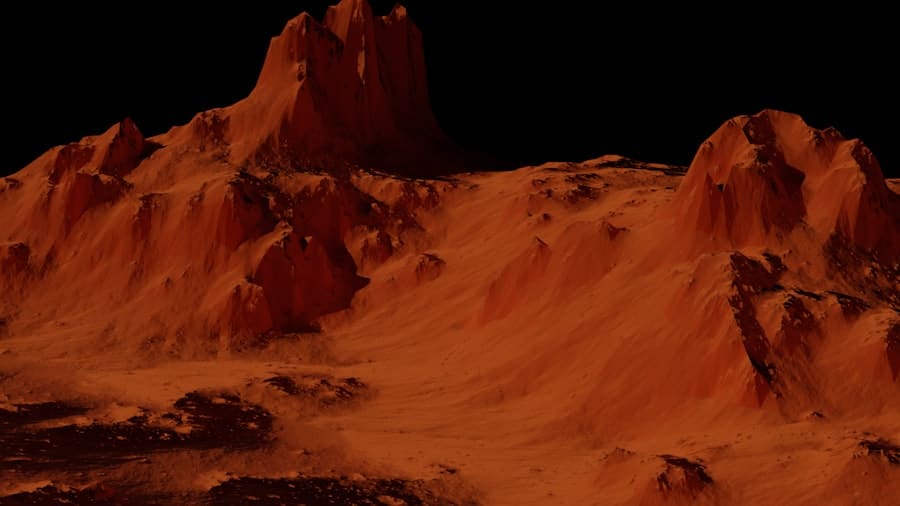Terraforming, a term derived from the combination of “terra,” meaning Earth, and “forming,” refers to the hypothetical process of altering the environment of a celestial body to make it habitable for Earth-like life.
The idea is not merely a fanciful notion; it is grounded in scientific principles and theories that explore how we might transform inhospitable worlds into thriving ecosystems.
The most discussed candidate for terraforming is Mars, given its similarities to Earth in terms of day length, axial tilt, and the presence of polar ice caps. The process of terraforming involves a series of complex and interrelated steps aimed at modifying the atmosphere, temperature, surface topography, and ecology of a planet. For Mars, this could mean increasing atmospheric pressure, introducing greenhouse gases to warm the planet, and potentially even seeding the surface with microbial life to kickstart a new biosphere.
The vision extends beyond just making Mars livable; it encompasses the broader idea of transforming other celestial bodies, such as Venus or moons like Europa and Titan, into environments where human life could flourish. The implications of successful terraforming are profound, as they could provide humanity with new frontiers for exploration and habitation, alleviating some of the pressures faced on Earth.
Key Takeaways
- Terraforming is the process of transforming a planet to make it habitable for humans and other Earth-based life forms.
- Challenges and limitations of terraforming Mars include its thin atmosphere, lack of liquid water, and extreme temperatures.
- Potential benefits of terraforming Mars and beyond include expanding human civilization, accessing new resources, and conducting scientific research.
- Ethical and environmental considerations of terraforming include the impact on native Martian life, potential ecological disruptions, and the rights of future generations.
- Current research and technology for terraforming focus on developing sustainable methods for creating habitable environments on other planets.
Challenges and Limitations of Terraforming Mars
Despite the allure of terraforming Mars, numerous challenges and limitations stand in the way of making this dream a reality. One of the most significant hurdles is the planet’s thin atmosphere, which is composed primarily of carbon dioxide and lacks the nitrogen and oxygen necessary for human life. To create a breathable atmosphere, vast amounts of gases would need to be introduced or generated on Mars.
This could involve industrial-scale processes to produce oxygen from water or carbon dioxide, but the energy requirements for such operations would be immense. Current technology does not yet allow for the efficient production and distribution of these gases on a planetary scale. Another major challenge is the planet’s low temperatures and lack of magnetic field.
Mars experiences extreme temperature fluctuations, with surface temperatures averaging around -80 degrees Fahrenheit (-62 degrees Celsius). To make the planet warm enough to support liquid water and life, significant warming strategies would need to be implemented. Some proposals suggest using orbital mirrors to reflect sunlight onto the surface or deploying large-scale greenhouse gas generators.
However, these methods are not only technologically daunting but also require long-term commitment and resources that may be difficult to sustain over decades or centuries.
Potential Benefits of Terraforming Mars and Beyond

The potential benefits of terraforming Mars extend far beyond simply creating a new home for humanity. One of the most compelling arguments for terraforming is the opportunity to alleviate some of the pressures facing Earth’s environment. As our planet grapples with climate change, overpopulation, and resource depletion, establishing a human presence on another planet could serve as a safety valve for our species.
By creating a self-sustaining colony on Mars, we could reduce the strain on Earth’s resources while simultaneously expanding our scientific knowledge and technological capabilities. Moreover, terraforming could lead to significant advancements in various fields such as environmental science, engineering, and biology. The challenges associated with transforming an entire planet would necessitate innovations in sustainable technologies, resource management, and ecological restoration techniques.
These advancements could have far-reaching implications not only for space exploration but also for addressing environmental issues on Earth. For instance, techniques developed for creating artificial ecosystems on Mars could be applied to restore degraded environments on our home planet.
Ethical and Environmental Considerations
As we contemplate the prospect of terraforming other planets, ethical considerations come to the forefront. One major concern is the potential impact on any existing Martian ecosystems or microbial life forms that may already exist. While current evidence suggests that Mars is largely barren, there is still a possibility that microbial life could be present beneath its surface or in subsurface water reserves.
The ethical dilemma arises from the question of whether humanity has the right to alter another planet’s environment, potentially leading to the extinction of native life forms. Additionally, there are broader ethical implications regarding our responsibilities as stewards of both Earth and other celestial bodies. The history of colonization on Earth has often been marked by exploitation and environmental degradation.
If we are to embark on terraforming projects, we must ensure that we do so with respect for any existing ecosystems and with a commitment to sustainability. This includes considering how our actions might affect future generations and ensuring that we do not repeat past mistakes in our quest for expansion.
Current Research and Technology for Terraforming
Research into terraforming is still largely theoretical, but several scientific initiatives are exploring the feasibility of transforming Mars into a habitable environment. One prominent area of study involves understanding Mars’ geology and climate through missions like NASA’s Perseverance rover and the European Space Agency’s ExoMars program. These missions aim to gather data on Martian soil composition, atmospheric conditions, and potential water sources—information that is crucial for developing effective terraforming strategies.
In addition to exploratory missions, advancements in technology are paving the way for potential terraforming efforts. For instance, researchers are investigating methods for producing oxygen from Martian resources using electrolysis—a process that splits water into hydrogen and oxygen using electricity. This technology could provide a sustainable source of breathable air for future colonists.
Furthermore, studies on genetically engineered organisms capable of surviving in harsh Martian conditions are underway. These organisms could play a vital role in initiating biological processes that contribute to creating a more hospitable environment.
Alternative Approaches to Making Other Planets Habitable

While Mars often takes center stage in discussions about terraforming, other celestial bodies present intriguing possibilities for human habitation as well. Venus, despite its extreme temperatures and crushing atmospheric pressure, has been proposed as a candidate for terraforming through radical approaches such as cloud cities or floating habitats in its upper atmosphere. These concepts envision creating buoyant structures that could house human populations while avoiding the harsh conditions on the surface.
Moons like Europa and Titan also offer unique opportunities for potential habitability. Europa’s subsurface ocean may harbor conditions suitable for life, while Titan’s thick atmosphere and liquid methane lakes present an entirely different set of challenges and possibilities. Instead of traditional terraforming methods, these moons might benefit from localized bioengineering efforts or habitat construction that leverages their existing environments rather than attempting to transform them entirely.
The Role of Space Agencies and Private Companies in Terraforming
The pursuit of terraforming is not solely the domain of government space agencies; private companies are increasingly entering the arena with ambitious plans for space exploration and colonization. Organizations like SpaceX have made headlines with their vision for establishing a human settlement on Mars within the next few decades. Their focus on developing reusable rocket technology aims to reduce costs associated with space travel, making it more feasible to transport people and resources necessary for terraforming efforts.
In parallel, traditional space agencies such as NASA and ESA continue to conduct research that lays the groundwork for future terraforming initiatives. Collaborative efforts between public institutions and private enterprises may accelerate progress in this field by pooling resources, expertise, and innovative ideas. As both sectors work toward common goals—whether it be establishing a human presence on Mars or developing technologies for sustainable living in space—the synergy between them could prove essential in overcoming the challenges associated with terraforming.
The Future of Human Colonization beyond Earth
The future of human colonization beyond Earth hinges on our ability to adapt to new environments while ensuring that we do so responsibly and ethically. As we stand on the brink of interplanetary exploration, the lessons learned from our attempts at terraforming will shape not only our approach to other planets but also our understanding of sustainability on Earth itself. The prospect of establishing colonies on Mars or other celestial bodies raises questions about what it means to be human in an expanding universe.
As we look ahead, it is essential to foster an inclusive dialogue about colonization that encompasses diverse perspectives—from scientists and ethicists to indigenous voices who have experienced colonization firsthand on Earth. By engaging in thoughtful discussions about our responsibilities as explorers and stewards of other worlds, we can work toward a future where humanity thrives not just on Earth but across the cosmos while respecting the integrity of all environments we encounter along the way.
In the quest to explore the potential of terraforming Mars and beyond, it’s essential to consider the technological advancements that can support such ambitious endeavors. An interesting related article that delves into the technological infrastructure necessary for such projects is available on Enicomp’s blog.
For more information, you can read the full article by visiting Enicomp’s Blog.
FAQs
What is terraforming?
Terraforming is the theoretical process of transforming a planet, moon, or other celestial body to make it more Earth-like and habitable for human life.
What are the potential benefits of terraforming Mars?
Terraforming Mars could potentially provide a second habitable planet for human colonization, expand the reach of human civilization, and offer new opportunities for scientific research and resource extraction.
What are the challenges of terraforming Mars?
Some of the major challenges of terraforming Mars include its thin atmosphere, lack of a global magnetic field, low gravity, and extreme temperatures. Additionally, the process would require significant time, resources, and technological advancements.
Are there ethical considerations to terraforming other planets?
Yes, there are ethical considerations related to the potential impact on any existing microbial life on Mars or other celestial bodies, as well as the potential consequences of introducing Earth-based life forms to these environments.
What are some proposed methods for terraforming Mars?
Proposed methods for terraforming Mars include releasing greenhouse gases to thicken the atmosphere, creating artificial magnetic fields to protect the planet from solar radiation, and introducing genetically engineered organisms to help create a more hospitable environment.
Could terraforming be applied to other celestial bodies in our solar system or beyond?
While Mars is the most commonly discussed candidate for terraforming, the concept could potentially be applied to other celestial bodies, such as Venus, the moon, or even exoplanets in other star systems. However, each body presents its own unique challenges and considerations.

